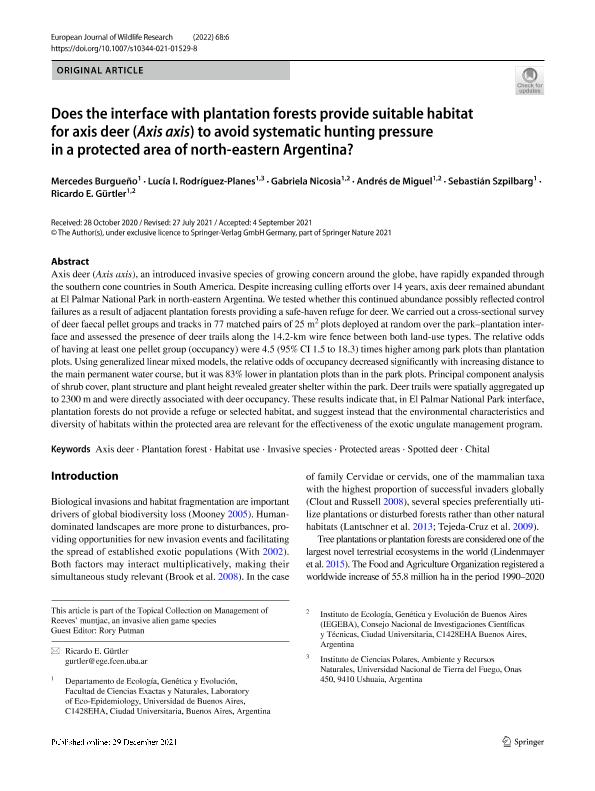Mostrar el registro sencillo del ítem
dc.contributor.author
Burgueño, Mercedes
dc.contributor.author
Rodríguez Planes, Lucía Inés

dc.contributor.author
Nicosia, Gabriela

dc.contributor.author
de Miguel, Andrés

dc.contributor.author
Szpilbarg, Sebastián
dc.contributor.author
Gurtler, Ricardo Esteban

dc.date.available
2023-10-04T13:38:34Z
dc.date.issued
2022-02
dc.identifier.citation
Burgueño, Mercedes; Rodríguez Planes, Lucía Inés; Nicosia, Gabriela; de Miguel, Andrés; Szpilbarg, Sebastián; et al.; Does the interface with plantation forests provide suitable habitat for axis deer (Axis axis) to avoid systematic hunting pressure in a protected area of north-eastern Argentina?; Springer; European Journal of Wildlife Research; 68; 1; 2-2022; 1-12
dc.identifier.issn
1612-4642
dc.identifier.uri
http://hdl.handle.net/11336/214060
dc.description.abstract
Axis deer (Axis axis), an introduced invasive species of growing concern around the globe, have rapidly expanded through the southern cone countries in South America. Despite increasing culling efforts over 14 years, axis deer remained abundant at El Palmar National Park in north-eastern Argentina. We tested whether this continued abundance possibly reflected control failures as a result of adjacent plantation forests providing a safe-haven refuge for deer. We carried out a cross-sectional survey of deer faecal pellet groups and tracks in 77 matched pairs of 25 m2 plots deployed at random over the park–plantation interface and assessed the presence of deer trails along the 14.2-km wire fence between both land-use types. The relative odds of having at least one pellet group (occupancy) were 4.5 (95% CI 1.5 to 18.3) times higher among park plots than plantation plots. Using generalized linear mixed models, the relative odds of occupancy decreased significantly with increasing distance to the main permanent water course, but it was 83% lower in plantation plots than in the park plots. Principal component analysis of shrub cover, plant structure and plant height revealed greater shelter within the park. Deer trails were spatially aggregated up to 2300 m and were directly associated with deer occupancy. These results indicate that, in El Palmar National Park interface, plantation forests do not provide a refuge or selected habitat, and suggest instead that the environmental characteristics and diversity of habitats within the protected area are relevant for the effectiveness of the exotic ungulate management program.
dc.format
application/pdf
dc.language.iso
eng
dc.publisher
Springer

dc.rights
info:eu-repo/semantics/openAccess
dc.rights.uri
https://creativecommons.org/licenses/by-nc-sa/2.5/ar/
dc.subject
AXIS DEER
dc.subject
CHITAL
dc.subject
HABITAT USE
dc.subject
INVASIVE SPECIES
dc.subject
PLANTATION FOREST
dc.subject
PROTECTED AREAS
dc.subject
SPOTTED DEER
dc.subject.classification
Ecología

dc.subject.classification
Ciencias Biológicas

dc.subject.classification
CIENCIAS NATURALES Y EXACTAS

dc.title
Does the interface with plantation forests provide suitable habitat for axis deer (Axis axis) to avoid systematic hunting pressure in a protected area of north-eastern Argentina?
dc.type
info:eu-repo/semantics/article
dc.type
info:ar-repo/semantics/artículo
dc.type
info:eu-repo/semantics/publishedVersion
dc.date.updated
2023-07-07T22:19:48Z
dc.journal.volume
68
dc.journal.number
1
dc.journal.pagination
1-12
dc.journal.pais
Alemania

dc.description.fil
Fil: Burgueño, Mercedes. Universidad de Buenos Aires. Facultad de Ciencias Exactas y Naturales. Departamento de Ecología, Genética y Evolución; Argentina
dc.description.fil
Fil: Rodríguez Planes, Lucía Inés. Universidad Nacional de Tierra del Fuego, Antártida e Islas del Atlántico Sur. Instituto de Ciencias Polares, Ambientales y Recursos Naturales; Argentina. Consejo Nacional de Investigaciones Científicas y Técnicas; Argentina. Universidad de Buenos Aires. Facultad de Ciencias Exactas y Naturales. Departamento de Ecología, Genética y Evolución; Argentina
dc.description.fil
Fil: Nicosia, Gabriela. Consejo Nacional de Investigaciones Científicas y Técnicas. Oficina de Coordinación Administrativa Ciudad Universitaria. Instituto de Ecología, Genética y Evolución de Buenos Aires. Universidad de Buenos Aires. Facultad de Ciencias Exactas y Naturales. Instituto de Ecología, Genética y Evolución de Buenos Aires; Argentina
dc.description.fil
Fil: de Miguel, Andrés. Consejo Nacional de Investigaciones Científicas y Técnicas. Oficina de Coordinación Administrativa Ciudad Universitaria. Instituto de Ecología, Genética y Evolución de Buenos Aires. Universidad de Buenos Aires. Facultad de Ciencias Exactas y Naturales. Instituto de Ecología, Genética y Evolución de Buenos Aires; Argentina
dc.description.fil
Fil: Szpilbarg, Sebastián. Universidad de Buenos Aires. Facultad de Ciencias Exactas y Naturales. Departamento de Ecología, Genética y Evolución; Argentina
dc.description.fil
Fil: Gurtler, Ricardo Esteban. Consejo Nacional de Investigaciones Científicas y Técnicas. Oficina de Coordinación Administrativa Ciudad Universitaria. Instituto de Ecología, Genética y Evolución de Buenos Aires. Universidad de Buenos Aires. Facultad de Ciencias Exactas y Naturales. Instituto de Ecología, Genética y Evolución de Buenos Aires; Argentina
dc.journal.title
European Journal of Wildlife Research

dc.relation.alternativeid
info:eu-repo/semantics/altIdentifier/url/https://link.springer.com/article/10.1007/s10344-021-01529-8
dc.relation.alternativeid
info:eu-repo/semantics/altIdentifier/doi/http://dx.doi.org/10.1007/s10344-021-01529-8
Archivos asociados
